
To put it in the terms used by our friend Harris, the weather has been a little "schizo" this Spring. When the forecast predicts rain, we are treated to (the always welcome) blue sky. When fair skies are expected, we are subjected to a deluge. One day last week, the evening news weather forecast promised that it would rain the entire following day. Rather than just sit at home and watch the "rain in vain," we decided to make the most of the drearily inclement weather and prepare a recipe that we had recently read for slow cooked beef cheeks. This particular recipe requires the cheeks to cook at a low oven temperature for 8 to 10 hours. What better way to enjoy what otherwise would be a total washout?
Our basic recipe was from Daniel Patterson's piece in the NYT Magazine (5/7/06). We also consulted Tom Colicchio's "Cook Like a Chef" before departing for Staubitz, our nearby butcher where we purchased a pound of beef cheeks for less than $5. After first browning our cheeks on the stovetop, we popped them in a 180 degree oven where they quietly remained for 6 hours the first day and additional 4 hours the next. But, even after 10 hours, these cheeks hadn't reached the tenderness that we were seeking so, we raised the temperature to 350 degrees (taking a cue from the Colicchio method) and cooked them for another 30 minutes. That did the trick! The cheeks were now ready to eat -- very tender but not quite falling apart. We served them with two of Spring's quintessential ingredients, fresh greenmarket asparagus and ramps. When we initally planned our menu, we fully expected to have leftovers for following day but, before we realized it, all that was left was the smile on our faces!
This recipe was very easy to make but, who has the time to stay home and babysit their oven for 10 hours? All that we can say is that if you do, you will be rewarded with a juicy, tender and richly flavored dish that will have you wishing you could do it again the next day.
By the way, in case you were wondering about the weather on those two days that it took for us to cook the beef cheeks.... the sky was blue and we didn't see a drop of rain!

Slow-Cooked Beef Cheeks with Spring Vegetables and Rosemary
inspired by Daniel Patterson's recipe on 5/7/06 NYT Magazine
Serves 2
1 beef cheek
salt and black pepper
olive oil
1/2 yellow onion, sliced 
2 cloves of garlic, sliced
1 carrot, peeled and sliced
3 sprigs rosemary
1 cup beef stock and 1 cup chicken stock
4 asparagus, cut into 1-inch lengths
4 ramps, steamed
1 tablespoon minced chives
Season the beef cheeks with salt and pepper. Brown the meat in a braising pan in olive oil. Transfer the meat onto a plate. In the same pan, sautee the onion, carrots, and garlic with pinch of salt and pepper in low heat until the onion is tender. Remove from the heat and add the rosemary and return the meat to the pan. Let stand 15 minutes, until cooled.
Pour the stock into the pan, but not to cover the meat completely. Cover the pan and put in a cold oven. Turn the oven to 180 degrees and cook for 8 to 10 hours, until the meat is very tender. You can cook the cheeks partly, then put them into the refrigerator and finish them later. Raise the tempreture to 350 degrees for 1/2 to 1 hours if you need to, until the meat has reached the desired tenderness.
Cook the asparagus in salted boiling water for about 2 minutes, drain well and set aside. Steam the ramps about 4 minutes, drain well and set aside. Adjust the beef and broth for seasoning, and slice the meat for serving. Place the meat and vegetables in a bowl, and laddle some broth over the top. Sprinkle with chives.


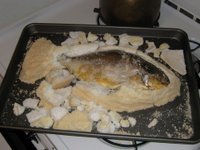


















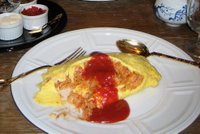
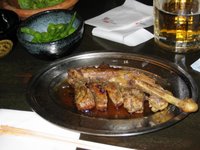

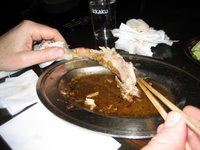



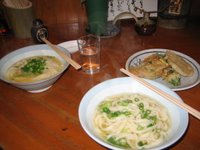





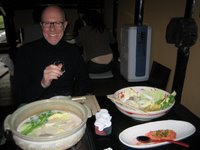


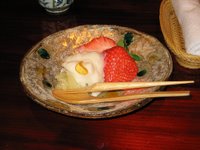






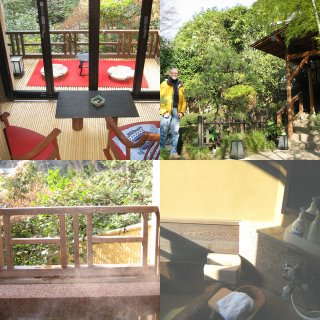

 Meal at the ryokan was a feast consisting of a parade of local delicacies. Our personal room attendant would leave the room and return every tweny minutes or so, each time returning with another dish...it seemed endless! One of the early courses of sashimi even included a live lobster on our plate. The lobster was still moving even though the body had been cut into sashimi!
Meal at the ryokan was a feast consisting of a parade of local delicacies. Our personal room attendant would leave the room and return every tweny minutes or so, each time returning with another dish...it seemed endless! One of the early courses of sashimi even included a live lobster on our plate. The lobster was still moving even though the body had been cut into sashimi!

